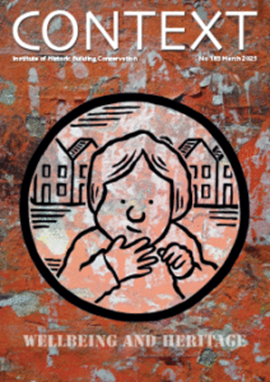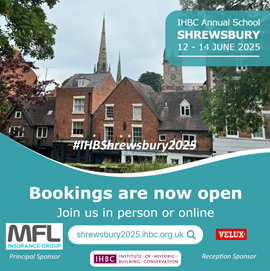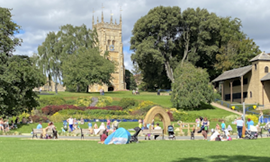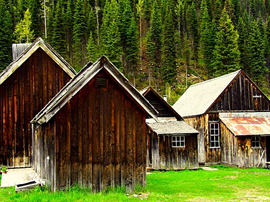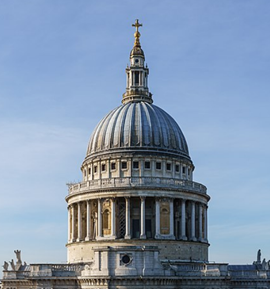Arts and Crafts Churches

|
| Arts and Crafts Churches, Alec Hamilton, Lund Humphries, 2020, 352 pages, 350 colour illustrations. |
It may seem surprising, given today’s interest in the arts and crafts movement, that this is the first published study of arts and crafts churches. This may be in part because it is difficult to identify what is an arts and crafts church, a dilemma that faced the book’s author Alec Hamilton when he began his research. Does it depend, he asks, on the designer being a member of the Art Workers’ Guild or someone who exhibited with the Arts and Crafts Exhibition Society? Is it enough for it to look arty crafty? Might it have something to do with the dwindling belief in an all-powerful God? Or is it simply that such churches were no longer Victorian?
As Hamilton points out, despite what Pevsner liked to think, arts and crafts churches did not prefigure modernism, for their designers looked not to the future, but back with nostalgia to a kind of vernacular based on an idealised vision of the past. Attention to decorative detail, the mark of craftsmanship, beauty and truth were more important than ecclesiological orthodoxy or purposeful construction, values that had underpinned the gothic revival. Perhaps, he concludes, the arts and crafts church is not an architectural category at all, but the transcendence of religion by art.
These thoughtful observations are debated in the introductory section that explores the social, political, religious and artistic context of the period from 1884, the founding date of the Art Workers’ Guild, to 1918. The remainder of the book consists of a comprehensive gazetteer of churches, arranged on a regional basis, including Wales and Scotland as well as England. Entries for well-known churches, such as Brockhampton, Roker and Holy Trinity, Sloane Street are comparatively brief as there are articles or even books on these paradigms, as cited in the bibliography. The aim of the gazetteer is to send the reader to little-known churches.
Within each region, the churches are described in order of significance. A large number of ‘other churches’ worth seeking out are listed at the end of each chapter. Interspersed are informative topic pages covering leading architects such as John Dando Sedding and Robert Lorimer, or lesser-known but no less interesting ones like John Sydney Brocklesby and Charles Ponting. Other topics include Oxford College Chapels, Colliers’ Churches, the Settlement Movement, and the craftsmen and craftswomen whose work is of such importance. One remarkable aspect is the contribution made by women, even though they were excluded from becoming members of the Art Workers’ Guild. Such were the Pinwell sisters, skilled woodcarvers who formed a company in Devon, and the Rope cousins, who produced beautiful stained glass. They, and the more celebrated feminist icon Phoebe Traquair, all deservedly get topic pages.
Beautifully illustrated and well-produced, the book encourages browsing; and when it becomes possible to do so, it will act as an invaluable companion for exploring these appealing buildings. As Hamilton observes, ‘Mostly the churches are loved – because they are lovable. They are so much less churchy than the gothic revival monsters of the middle of the century. They do not try to bring us to our knees which nowadays we tend not to want to be.’ Whether we are inspired to fall to our knees or remain upright, this is a book that could bring much pleasure to our recently restricted lives.
This article originally appeared as ‘Loved and lovable’ in Context 167, published by the Institute of Historic Building Conservation (IHBC) in March 2021. It was written by Peter de Figueiredo, reviews editor, Context.
--Institute of Historic Building Conservation
Related articles on Designing Buildings Wiki
- Architectural styles.
- Arts and craft movement.
- Bauhaus.
- Conservation.
- Context.
- English architectural stylistic periods.
- IHBC articles.
- Institute of Historic Building Conservation.
- Nikolaus Pevsner.
- United Free Church of Scotland: Design for Manses in the Highland Districts.
- Unlocking the Church: the lost secrets of Victorian sacred space.
IHBC NewsBlog
IHBC Context 183 Wellbeing and Heritage published
The issue explores issues at the intersection of heritage and wellbeing.
SAVE celebrates 50 years of campaigning 1975-2025
SAVE Britain’s Heritage has announced events across the country to celebrate bringing new life to remarkable buildings.
IHBC Annual School 2025 - Shrewsbury 12-14 June
Themed Heritage in Context – Value: Plan: Change, join in-person or online.
200th Anniversary Celebration of the Modern Railway Planned
The Stockton & Darlington Railway opened on September 27, 1825.
Competence Framework Launched for Sustainability in the Built Environment
The Construction Industry Council (CIC) and the Edge have jointly published the framework.
Historic England Launches Wellbeing Strategy for Heritage
Whether through visiting, volunteering, learning or creative practice, engaging with heritage can strengthen confidence, resilience, hope and social connections.
National Trust for Canada’s Review of 2024
Great Saves & Worst Losses Highlighted
IHBC's SelfStarter Website Undergoes Refresh
New updates and resources for emerging conservation professionals.
‘Behind the Scenes’ podcast on St. Pauls Cathedral Published
Experience the inside track on one of the world’s best known places of worship and visitor attractions.
National Audit Office (NAO) says Government building maintenance backlog is at least £49 billion
The public spending watchdog will need to consider the best way to manage its assets to bring property condition to a satisfactory level.







